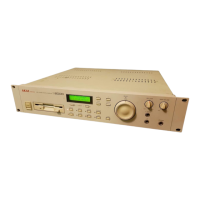PROGRAM EDIT
S2000 Operator’s Manual - Version 1.30 Page 101
The next page down gives access to the filter’s second modulation input:
LFO2 may be used for filter sweep effects such as flute tremolando or dramatic, resonant synth
effects. The ENV2 parameter sets the amount that envelope generator (EG)2 will sweep the
filter cutoff frequency.
The next page down gives access to the filter’s third modulation input:
As mentioned, most acoustic sounds have the phenomenon that, as the note dies away, so
the sound becomes slightly duller. We can use ENV2 to recreate this and this is especially
useful with looped sounds whose tonal ‘dynamics’ have become rather static due to the
looping process. By sweeping the filter cutoff frequency down during the course of a note, we
can artificially reconstitute the original sound’s tonal dynamics.
Of course, ENV2 may also be used to add synthesiser effects to a sound, especially with high
resonance settings. This can be used on samples of acoustic sounds, of course, but when
you take a ‘raw’ analogue synth waveform as your sample, the S2000 can be used as a
powerful analogue style synthesiser, processing the synth waveform in exactly the same way
as the original analogue synth the sound was taken from.
NOTE: This is a much more efficient use of memory. Instead of taking a sample of the synth
with filter sweep, etc. (which will speed up and slow down across the keyboard range and
requiring multi-sampling), sample the sound with the synth’s filters wide open, loop it and
‘reconstruct’ the original sound using the S2000’s filters.
In alkl three modulation pages, you may move the cursor to the controller field and select a
different controller to modulate the filter’s cutoff frequency. You could use the modwheel or
aftertouch to manually control the filter as a performance control. You could use LFO1 instead
of (or as well as) LFO1. ENV1 may be used instead of ENV2 so that the sound’s tonal changes
match exactly those of its amplitude changes.
NOTE: These are the pages you will see if you are creating a program based on the default
TEST PROGRAM. Because of Assignable Program Modulation (APM), however, these
assignments are not fixed and it is possible to assign virtually any controller to the filter’s cutoff
frequency. As a result, please note that if you have loaded a sound made previously on an
S2800, S3000, S3200, S3000XL or S3200XL, the modulation assignments shown in these
pages may differ from the ones shown above. For example, instead of ENV2, you may see
this:
You may change this simply by moving the cursor to the controller field and selecting the one
of your choice.

